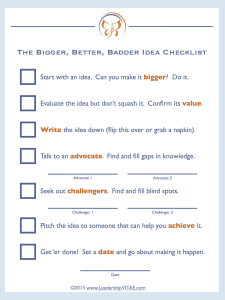Ideas are cheap. Before we begin investing time and resources moving forward with one, it’s free to change or refine it. Potential is endless in the world of ideas. [Tweet “Potential is endless in the world of ideas.”]
While opportunities abound, not all ideas are good ones. Just ask Tony Stark. In the latest Avengers movie, one of his ideas nearly causes the Earth’s destruction. Oops.
Most of our ideas don’t risk the world as we know it. However, we could jeopardize a project, customer relationship, or business.
An effective vetting process allows us to identify and mitigate risks during ideation, before they become reality in execution. Let’s evaluate Tony’s vetting process for the Ultron program to determine what we can do differently in our own ideation.
Self-Evaluation
Tony’s first step is to vet the idea internally. This is something we all do, formally or informally. We address initial doubts or misgivings, maybe poke at the idea to see if it passes a sniff test.
For many of us, ideas die in this step due to fear of embarrassment, cost, complexity, or other perceived limitations. However, given the size of his bank account and ego, such fears have no bearing in Tony’s decision-making. He has no natural internal limits, even on far-fetched ideas.
Since Tony’s an established genius, his internal vetting would be considerable and thorough. However, we each see things from our own perspective, with our own biases. Which is why we, and Tony, cannot stop there.
Peer-Evaluation
The next step is to share the idea with others, putting words to the mental image of our idea. In verbalizing it, we may immediately find gaps or challenges. Even when we are internally thorough, the process of translating the idea into words helps solidify or clarify that which was vague or uncertain. [Tweet “Translating an idea into words helps solidify or clarify that which was vague or uncertain.”]
Tony’s sounding board is Bruce Banner, the alter-ego of the Hulk. Bruce is a fellow scientist and genius, able to quickly grasp Tony’s idea. He can see the value in the Ultron program, but also huge risks, which he verbalizes.
Tony is quick to refute and diminish Bruce’s concerns. He sways Bruce and they move forward together. At this point, Bruce plays his true role, filling in technical gaps and challenges that Tony could not address alone. They succeed in building Ultron, which quickly becomes a nightmare.
Where did Tony go wrong? While Tony verbalized his idea, his mistake was in using only one sounding board and who he selected to fill that role.
Tony and Bruce have an affinity as scientists, meaning it is similar to Tony talking to himself. Bruce offered no new concerns to the ones Tony considered and dismissed as insignificant, relative to the greater good of the Ultron program.
Personalities are the key difference between the two men. Due to the risks associated with his anger (hello green guy), Bruce does not challenge the way Tony does. It is relatively easy for Tony to get what he wants, and is another reason why this particular peer review was insufficient.
360° Review
Tony’s critical gap was the lack of a 360° review in his vetting process.
He is part of a team – the Avengers. Each of them bring different perspectives to the table, balancing the natural affinity he shares with Bruce, as well as offering personalities that are more difficult to intimidate.
In particular, Tony had a complete miss when he failed to engage Steve Rodgers, his polar opposite.
While Tony wants to help people, he trusts technology and science to do the best job of making their lives safer. He and Bruce both feel more comfortable around gizmos and gadgets than people.
Steve is a soldier first, here to protect mankind from aliens, technology run amok or even himself. He is exactly the foil Tony needs to fully vet his idea, ensuring the true risks are voiced and addressed prior to moving forward.
While it is easier to be surrounded by advocates, challengers provide us with the opposing point of view we need to prevent the Earth’s destruction. Or maybe some less dramatic failure or loss.
[Tweet “Challengers provide us with the opposing point of view we need to prevent disaster.”]
Ideation to Execution
Eventually, the good guys won…after much angst and destruction. In real life, the impact may be less dramatic, but negative nonetheless. And we may not emerge victorious.
In order to increase the likelihood that our ideas are feasible, achievable and worth pursuing, there are 7 steps we can all follow:
- Have an idea. Use that gray matter to come up with something new. Even “small” ideas can have a big impact, so grab on to those nuggets of inspiration when they happen.
- Engage in self-talk. Consider positives and negatives, potential holes and gaps. Do not let doubt squash the idea if it appears to have merit. Is it possible? Does it have value? If so, keep going.
- Write the idea down. We frequently need to put pen to paper to make our thoughts coherent. Does the idea still hold up under visual scrutiny? Drawing a picture brings a mental image to life and may be more appropriate than words.
- Talk to an advocate. Reach out to a trusted friend or colleague, maybe someone in a similar field or role. Sharing the idea with a supportive, constructive ear will help address gaps and smooth the rough edges.
- Seek out the opinion of challengers. Advocates make us feel good, but challengers make us think better. Look for those with different perspectives to identify blind spots and missed risks. Include someone who knows the customer base, has technical ability we lack, or is an expert in unfamiliar territory.
- Make the pitch. Once the idea is refined, present it to people that can make it happen. It could be a bank for funding, a manager for resources, or someone that sponsors creative talents. Just remember, “no” may mean going back to an earlier step for further refinement. Anything worth doing may take a few iterations to get to “YES.”
- Get ‘er done! Don’t stop now…it’s time to make that idea a reality!

Ready to make your ideas reality? Click here to download my bigger, better, badder idea checklist. If you do, please share any feedback you have so I can continue to create useful downloads for new and experienced leaders.
For more information about big ideas and making them happen, check out 1900 Hours in my book: 24 Hours of Life and Leadership, the Marine Corps Way.
Tony Stark may be a genius, but even the smartest of us can benefit from vetting our ideas before making them a reality. What steps do you follow between ideation and execution? What would you do differently?
I’d love if you could share your thoughts in the comments and keep the conversation going.









